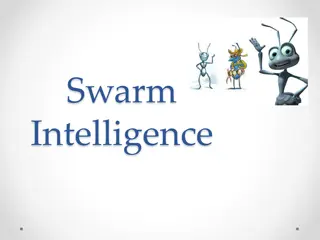Understanding Network-on-Chip Communication and Optimization
Network-on-Chip (NoC) is essential for communication among system elements in large systems. It involves topology, flow control, congestion handling, and routing optimization techniques like virtual channels. Learn about the key aspects and challenges in designing efficient NoCs.
Download Presentation

Please find below an Image/Link to download the presentation.
The content on the website is provided AS IS for your information and personal use only. It may not be sold, licensed, or shared on other websites without obtaining consent from the author. Download presentation by click this link. If you encounter any issues during the download, it is possible that the publisher has removed the file from their server.
E N D
Presentation Transcript
NoC Po-An Tsai 6.823S15 Recitation
NoC Network-on-chip is about how elements (cores, cache banks, memory controller, I/O controller etc.) communicate with each other Important when you have a large system
http://www.extremetech.com/wp- content/uploads/2013/11/KNL13.png
Topology How different nodes connect to each other Ring Mesh/Torus Tree Important properties Diameter Avg. distance Bisection bandwidth Links (overhead)
Topology Diameter? 2 Problem 8.2 Average Hop Count? (AB+AC+AD+BA+BC+BD+CA+ CB+CD+DA+DB+DC)/12 = 7/6 Bisection Bandwidth? 4 if all links bi-directional
Flow control How messages are forwarded from src to dst Buffered/ Bufferless Wormhole is the most common one but there is head-of-line blocking problem
Head-of-line Blocking in Street Network Congested Waiting for the Waiting for the left turn left turn We want to We want to go straight!! go straight!! This is why we have such lanes as straight only or left turn only 7
Congestion & HoL Blocking Head-of-Line (HoL) Blocking 1 A B
Congestion & HoL Blocking Head-of-Line (HoL) Blocking 1 A B C D 2 Solution: Virtual Channels
Congestion & HoL Blocking Head-of-Line (HoL) Blocking 1 A B C D 2 Solution: Virtual Channels
Routing What is the path between src and dst Use mesh as example here Choose a path so that the message can arrive faster Choose a path to ensure no deadlock/livelock
Turn Model The eight possible turns and cycles in a 2D mesh Only four turns are allowed in the XY routing algorithm
Turn Model 1 2 AND 3 4
Turn Model 1 2 West-First AND 3 4
Turn Model 1 2 West-First AND 3 4
Turn Model 1 2 West-First AND 3 4 North-Last
Turn Model 1 2 West-First AND 3 4 Negative-First North-Last
Channel dependency graph (CDG) Problem 8.2
8.2.B: CDG Deadlock free? No
8.2.C: Minimal Routing X X X X X X X X X X X X Deadlock free? Yes
Dimension-Order Routing (DOR) Approaches in one dimension first, then in the other Bandwidth No path diversity DA DB Latency Minimal routing SA Deadlock Prevention Deadlock-free with 1 VC SB DOR (XY)
Valiant Uses one random intermediate node per each packet Bandwidth Wide path diversity IB DA IA DB Latency Poor latency SA Deadlock Prevention Deadlock-free with >= 2 VCs - each phase should use different VCs SB Valiant (XY/YX)
n-phase ROMM n-1 random intermediate node(s) only in MBR (Minimum Bounding Rectangle) Bandwidth More path diversity than DOR Limited by the value of n DA DA IBIB DB DB Latency Minimal routing SA SA IA IA Deadlock Prevention Deadlock-free with >= n VCs - each phase should use different VCs SB SB 2-phase ROMM (XY/YX)
Routing and Performance DA SA SB ROMM DOR Valiant O1TURN - Depend on traffic patterns - In general, path diversity helps lower congestions due to load balancing.
The end Next time: Router architecture Cache coherence























